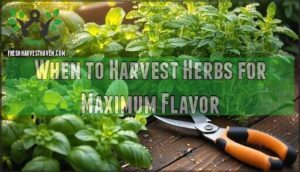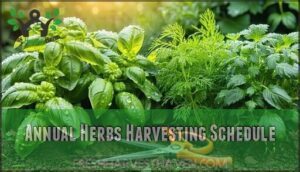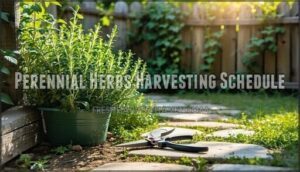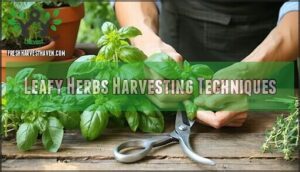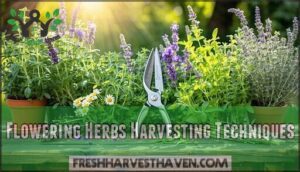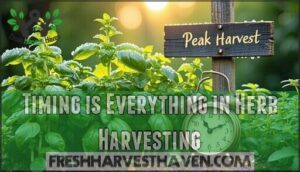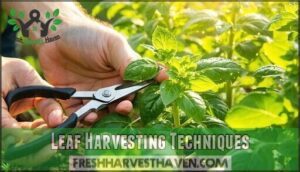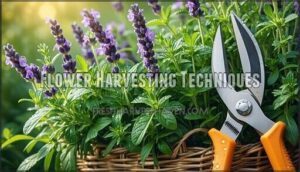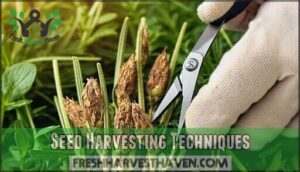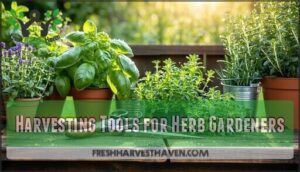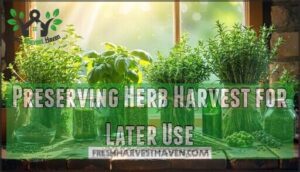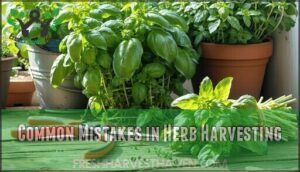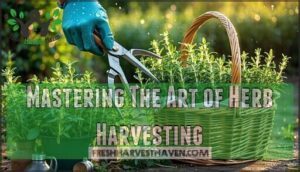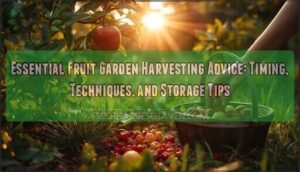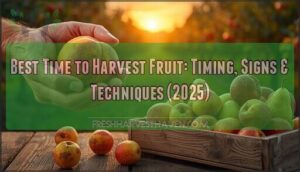This site is supported by our readers. We may earn a commission, at no cost to you, if you purchase through links.
 You’ll get the best flavor when you harvest herbs in the early morning, right after the dew dries but before the sun gets too hot.
You’ll get the best flavor when you harvest herbs in the early morning, right after the dew dries but before the sun gets too hot.
This timing captures peak essential oils that give herbs their punch. For leafy herbs like basil and parsley, pick them just before they flower – that’s when they’re at their flavor peak.
Perennial herbs like rosemary can handle regular harvesting throughout the growing season. Always use clean, sharp scissors and cut just above a leaf node to encourage new growth.
The secret isn’t just when you harvest, but understanding each herb’s unique flavor cycle and peak moments.
Table Of Contents
- Key Takeaways
- Herb Harvesting for Best Flavor
- When to Harvest Herbs for Maximum Flavor
- Harvesting Herbs by Type
- Timing is Everything in Herb Harvesting
- Harvesting Different Parts of Herbs
- Harvesting Tools for Herb Gardeners
- Preserving Herb Harvest for Later Use
- Maximizing Herb Flavor and Aroma
- Common Mistakes in Herb Harvesting
- Mastering The Art of Herb Harvesting
- Frequently Asked Questions (FAQs)
- When should you harvest herbs?
- How do you pick herbs?
- How do you know when to harvest herbs?
- When should you pick herbs?
- How do you harvest herbs in the morning?
- When should you harvest herbs for drying?
- How do I know when my herbs are ready to be picked?
- How do you get the most flavor out of fresh herbs?
- Why pick herbs in the morning?
- When should I cut my herbs?
- Conclusion
Key Takeaways
- You’ll capture peak essential oils by harvesting herbs in early morning after dew dries but before the sun gets too hot – this timing delivers maximum flavor intensity.
- Don’t harvest more than one-third of any herb plant at once, and always cut just above leaf nodes with sharp, clean scissors to encourage healthy regrowth.
- Time your harvest before herbs flower since pre-flowering stages contain the highest concentration of essential oils – once flowering begins, flavor diminishes as energy shifts to bloom production.
- Choose vibrant, mature leaves that feel firm and smell aromatic, avoiding wet conditions after rain which dilute oils and create bland, waterlogged herbs.
Herb Harvesting for Best Flavor
You can’t just grab herb leaves whenever you feel like it and expect amazing flavor.
Timing transforms ordinary herbs into flavor powerhouses—master the moment, master the taste.
Herb harvesting requires precise flavor timing and optimal methods to maximize herb potency. The harvesting impact on culinary quality is huge.
Sharp scissors make clean cuts that keep plants healthy and productive.
Best flavor herbs come from understanding harvest timing—early morning after dew dries captures peak essential oils. Your optimal harvest time happens before flowering when oils concentrate in leaves.
Follow this herb flavor guide for consistently flavorful results.
When to Harvest Herbs for Maximum Flavor
When you’re hunting for maximum herb flavor, timing determines everything. Harvest at the flavor peak for best flavor herbs that’ll transform your cooking.
Perfect optimal timing turns ordinary herbs into culinary gold—it’s your secret weapon for amazing dishes.
Your herb flavor guide for optimal harvest time:
- Morning harvest between 6-10 AM when essential oils concentrate naturally
- Pre-flowering stage locks in intense flavors before energy shifts to blooms
- Leaf maturity at full development but still tender delivers peak taste
Master harvest timing, and you’ll never settle for bland herbs again.
Harvesting Herbs by Type
Understanding your herb types helps you harvest each plant at its peak flavor potential, since annual herbs like basil and cilantro require different timing than perennial varieties such as rosemary and thyme.
You’ll get the best results when you match your harvesting schedule to whether you’re growing soft herbs that complete their life cycle in one season or woody herbs that return year after year.
Annual Herbs Harvesting Schedule
When you’re growing annual herbs, timing your harvest makes all the difference for maximum flavor. Basil harvest time peaks just before flowers appear—usually 6-8 weeks after planting.
For cilantro cutting tips, snip leaves every 2-3 weeks before the plant bolts in warm weather. Dill growth stages allow continuous harvesting from seedling to pre-flower. Parsley harvesting frequency works best when you cut outer stems weekly, letting inner growth continue.
Follow this annual replanting schedule and when to pick herbs guide for maximum taste:
peak oils
Herb flavor preservation starts with perfect herb harvesting timing. To maximize flavor, remember to harvest herbs in the morning, when <strong>essential oils concentrate</strong>.
Perennial Herbs Harvesting Schedule
Unlike annuals, perennial herbs reward you with multiple harvests throughout their growing seasons.
Your rosemary harvest, sage harvesting, and thyme schedule follow predictable patterns that maximize ideal flavor while supporting long-term plant health.
Here’s your perennial herbs harvesting roadmap:
- Spring Growth Phase: Begin oregano timing when new shoots reach 4-6 inches, cutting just above leaf nodes for bushier growth.
- Summer Peak Season: Harvest mint management requires frequent cutting before flowering to maintain tender leaves and prevent aggressive spreading.
- Fall Preparation: Reduce harvesting frequency to help plants prepare for dormancy, ensuring strong regrowth next season.
To maintain plant health, remember to follow the one-third harvesting rule.
Master these harvesting techniques and you’ll enjoy fresh herb flavor preservation year-round from your established perennial herbs garden.
Leafy Herbs Harvesting Techniques
Mastering leaf selection starts with choosing young, vibrant leaves for ideal flavor.
Use the pinching technique for tender herbs like basil, or employ sharp cutting methods for tougher stems.
Tool sterilization prevents disease spread between plants.
Cut just above leaf nodes to promote growth encouragement.
These harvesting techniques maximize flavor intensity while ensuring your herb harvesting success continues throughout the growing season.
Flowering Herbs Harvesting Techniques
Flowering herbs demand precise timing for ideal flavor enhancement.
You’ll capture peak essential oils when harvesting during the flower stage—just before full bloom opens.
Cut stems at 45-degree angles using sharp shears.
Bud removal on leafy herbs prevents flavor changes and maintains potency.
Consider pollination impact when timing cuts.
Practice seed saving by letting some flowers mature completely for next season’s garden.
Timing is Everything in Herb Harvesting
You’ll get the most flavorful herbs when you harvest them at the right moment, and that timing depends on several key factors including the time of day, weather conditions, and plant maturity.
The difference between peak-flavor herbs and bland ones often comes down to choosing the correct hour to cut your plants and understanding when they’ve reached their prime growing stage.
Morning Harvesting for Best Flavor
Looking at different herb types, you’ll discover that timing your harvest makes all the difference. The early morning hours offer the sweet spot for herb harvesting when optimal flavor peaks.
As dew evaporates but before intense heat arrives, herbs contain their highest Optimal Oil Concentration. This Early Morning Benefits window captures maximum aroma intensity and Flavor Intensity before Sunlight Avoidance becomes necessary.
Early Morning Benefits include:
- Dew Impact naturally hydrates leaves without oversaturating them
- Essential oils haven’t evaporated from yesterday’s sun exposure
- Plants are fully hydrated from overnight moisture absorption
- Time of day allows gentle handling without wilting stress
- Cool temperatures preserve delicate leaf structures perfectly
Your herbs will reward this optimal flavor timing with vibrant taste that lasts through preservation.
Avoiding Rain and Water Harvesting
While morning timing sets the stage, weather conditions can make or break your herb harvesting success.
Water-soaked herbs spell trouble for ideal flavor.
Rain washes away precious essential oils, creating diluted oils that rob your herbs of their signature punch.
Wet leaves also invite mold risk and compromise herb quality through disease prevention issues.
Smart gardeners wait for dry conditions before harvesting.
Skip the post-rain harvest—those soggy leaves won’t deliver the flavor you’re after.
Instead, choose sunny days when morning dew has completely evaporated.
Your herbs need bone-dry surfaces to preserve their concentrated oils.
Condition Impact Solution
Patience pays off with bold, concentrated flavors.
Harvesting at Peak Maturity
Perfect timing catches herbs at their flavor peak—when essential oils reach maximum concentration.
Master these harvesting secrets and transform your garden into a flavor powerhouse that rivals any gourmet kitchen.
You’ll know your herbs have hit peak ripeness by checking these maturity indicators:
- Vibrant appearance: Leaves display rich color without yellowing or wilting
- Intense aroma: Strong fragrance when you gently rub the foliage
- Firm texture: Leaves feel sturdy and crisp to the touch
These harvesting windows guarantee peak potency and flavor intensity for your culinary creations.
Herbs, like vegetables, benefit from morning harvesting practices for best flavor.
Harvesting Different Parts of Herbs
You’ll need to choose the right part of each herb plant to harvest for maximum flavor, since leaves, flowers, and seeds all offer different tastes and uses in your cooking.
Each part requires specific timing and techniques to capture the best essential oils and prevent damage to your herb plants.
Leaf Harvesting Techniques
When harvesting leafy herbs, pinching methods and strategic cutting location matter most for flavor preservation.
Select sharp scissors for tool selection, making clean cuts just above leaf nodes to promote growth encouragement.
Target vibrant leaves during morning hours when essential oils concentrate for maximum herb flavor enhancement.
These proven herb harvesting techniques guarantee you’re collecting at peak potency.
Remember the one-third rule—never harvest more than that from any single plant.
Smart leaf harvesting keeps your herbs productive all season long.
Flower Harvesting Techniques
Flowers pack intense herb aroma intensity when harvested at the flower stage—just as buds open but before full bloom.
Cut stems early morning with sharp scissors for ideal flavor preservation.
Bud removal from leafy herbs redirects energy to foliage growth.
Harvest flowering herbs like lavender and chamomile affects pollination impact, so leave some blooms for bees.
Drying flowers preserves aromatic herbs for culinary uses year-round.
To avoid damage, use sharp pruning shears.
Seed Harvesting Techniques
While flower harvesting brings immediate rewards, seed harvesting offers long-term garden success.
You’ll capture future harvests by timing seed collection perfectly. Wait for complete seed maturity—when seed heads turn brown and crack open naturally.
Follow these proven seed harvesting steps:
- Check readiness: Harvest on dry days when seeds rattle inside brown pods
- Clean collection: Use sharp scissors to cut seed heads into paper bags
- Proper storage: Apply drying methods before storing in airtight containers for maximum viability testing results
Harvesting Tools for Herb Gardeners
Having the right tools makes herb harvesting easier and protects your plants from damage.
You’ll need sharp, clean scissors or pruners for woody herbs like rosemary and sage, while your fingertips work perfectly for pinching soft herbs like basil and cilantro.
Choosing The Right Pruning Shears
Quality pruning shears transform herb harvesting from a chore into pure joy.
When you’re selecting the perfect tool, blade material makes all the difference—carbon steel maintains sharpness longer while stainless steel resists rust.
Handle comfort shouldn’t be overlooked, especially during extended pruning sessions.
Consider these essential features for effective herb harvesting tools:
- Shear types: Bypass pruners create cleaner cuts than anvil styles for delicate herbs
- Cutting capacity: Match blade size to your herb stems—small snips for basil, larger pruners for woody rosemary
- Blade material: Carbon steel offers superior durability and easy sharpening
- Handle comfort: Ergonomic grips reduce hand fatigue during long herb pruning sessions
- Maintenance needs: Choose tools that disassemble easily for thorough cleaning
Invest in quality herb snips—your plants will thank you with better growth and flavor.
Consider browsing a selection of herb pruning shears for the best options.
Using Sharp and Clean Scissors
Your scissors matter more than you think for herb harvesting quality. Sharp blades create clean cuts that preserve fresh herb harvest flavor, while dull ones crush stems and invite disease.
Maintain blade sharpness through regular tool sterilization with rubbing alcohol, preventing damage to your plants. For consistently precise cuts, consider investing in specialized cutting tools. Proper scissors maintenance guarantees every snip delivers the herb flavor you’re after.
Task Why It Matters Pro Tip
Harvesting Techniques for Herb Gardeners
Mastering herb harvesting requires understanding various techniques that maximize flavor while promoting healthy plant growth.
Your approach determines both immediate harvest quality and long-term garden productivity.
Essential harvesting methods include:
- Cut-and-Come-Again: Trim stems above leaf nodes for continuous regrowth
- Pinching Methods: Gently remove tender shoots to encourage bushier growth
- Flower Bud Removal: Prevent flowering to maintain leaf flavor intensity
- Harvest Limits: Never take more than one-third of any plant
Specialized tools aid in precise herb cutting.
Tool Maintenance guarantees clean cuts that prevent disease transmission between plants, supporting timely timing for peak herb flavor.
Pinching and Cutting Herbs
Pinching techniques work best for tender herbs like basil—simply squeeze stems between your thumb and forefinger.
For tougher plants, cutting methods with sharp scissors give cleaner results.
Your tool selection affects growth impact substantially.
The pinch method encourages bushier plants, while cut-and-come-again harvesting maintains steady flavor production when you time it right.
Selective Harvesting Methods
Smart herb harvesting means picking strategically, not randomly grabbing whatever’s within reach. You’ll maximize herb flavor while keeping plants healthy through targeted approaches.
Targeted Leaf Selection focuses on mature outer leaves first. Flower Bud Removal redirects energy into leaf production. Seed Head Pruning prevents unwanted flowering.
These herb harvesting methods guarantee continuous growth:
- Remove older leaves from the bottom up for sustained production
- Pinch flower buds early to concentrate flavors in foliage
- Trim selectively rather than shearing entire sections at once
Balancing Harvest and Growth
Harvest-and-growth balance determines your herb garden’s long-term success.
You’ll maintain plant vigor by cutting stems just above leaf nodes, encouraging fresh regrowth strategies. Rotate harvesting areas every two weeks to prevent stress while supporting continuous yield and root health.
To guarantee the best flavor, remember to harvest herbs early in the morning.
| Sustainable Harvesting Practice | Timing Schedule |
|---|---|
| Pinch above leaf nodes | Weekly maintenance |
| Rotate harvest locations | Every 2 weeks |
| Monitor herb growth stages | Daily observation |
| Check herb maturity levels | Before each harvest |
| Assess overall plant condition | Monthly review |
Preserving Herb Harvest for Later Use
Once you’ve harvested your herbs at their peak flavor, you’ll want to preserve them properly so you can enjoy their fresh taste throughout the year.
The three most effective preservation methods are drying herbs for long-term storage, freezing them to maintain freshness, and pickling certain varieties to create unique flavors for your cooking.
Drying Herbs for Storage
Three methods will transform your fresh herb harvesting into flavorful dried treasures.
Air drying works perfectly—bundle herbs with rubber bands and hang them in a dark, well-ventilated space for one to three weeks.
Dehydrator methods preserve herb flavor while cutting drying time to hours instead of weeks.
For quick results, try oven drying at the lowest temperature with the door slightly open.
Microwave drying between paper towels works for small quantities.
Silica gel packets speed up herb drying while maintaining color and potency for long-term herb storage.
Freezing Herbs for Freshness
While drying preserves herbs beautifully, freezing herbs offers unmatched freshness and flavor retention.
You’ll capture that just-picked taste by using proper freezing methods and herb selection. Choose vibrant, healthy leaves for best results.
- Ice cube method: Chop herbs, fill trays with water or olive oil, freeze solid
- Flash freezing: Lay whole leaves on baking sheets, freeze, then transfer to best containers
- Herb storage bags: Pack chopped herbs in labeled freezer bags, removing excess air
- Thawing herbs: Use frozen directly in cooking—no thawing needed for most dishes
Pickling Herbs for Flavor
Pickling transforms your freshly harvested herbs into tangy treasures that last months.
You’ll want to select robust varieties like rosemary, thyme, and oregano for best results.
| Vinegar Types | Best Herb Combinations |
|---|---|
| White vinegar | Dill, garlic, peppercorns |
| Apple cider vinegar | Sage, thyme, bay leaves |
| Rice vinegar | Basil, cilantro, ginger |
| Red wine vinegar | Rosemary, oregano, garlic |
| Balsamic vinegar | Mint, lavender, lemon zest |
The pickling process requires proper storage methods in sterilized jars for maximum herb flavor preservation.
Maximizing Herb Flavor and Aroma
You’ll get the strongest flavor and most intense aroma from your herbs when you harvest them at precisely the right moment, which occurs when their essential oils reach peak concentration.
The timing, storage method, and harvesting technique you choose directly affect how much flavor your herbs retain, whether you’re using them fresh or preserving them for later use, and this is crucial for maintaining their essential oils.
Harvesting at Peak Aroma
Since essential oils reach Optimal Potency during Morning Harvest hours, you’ll capture peak Aroma Development by timing your herb harvesting before 10 AM.
Environmental Impact from heat and sun diminishes fragrance intensity throughout the day.
Trust your Sensory Evaluation skills—when basil or rosemary releases strong scent, that’s your cue.
Optimal timing for herb harvesting and aroma development transforms ordinary dishes into extraordinary culinary experiences.
Preserving Herbs for Maximum Flavor
After harvesting herbs at their peak, proper preservation locks in maximum flavor.
Your garden’s bounty doesn’t have to fade with the seasons when you master these herb preservation techniques.
Essential herb harvesting best practices for flavor development include:
- Drying Techniques: Bundle herbs and hang in cool, dry spaces for concentrated flavors
- Freezing Methods: Create oil infusions by freezing chopped herbs in olive oil cubes
- Salt Preserves: Layer herbs with coarse salt for long-lasting, intensely flavored seasonings
These methods guarantee your harvesting herbs efforts yield year-round culinary rewards.
Storing Herbs for Freshness
Now that you’ve preserved your herbs using various drying methods and freezing techniques, proper storage becomes your flavor’s best friend.
Store dried herbs in airtight glass jars away from light and heat. Fresh herbs stay crisp in the refrigerator for days when stored correctly.
| Storage Method | Best For | Duration |
|---|---|---|
| Airtight Jars | Dried herbs, oil infusions | 6-12 months |
| Refrigerator | Fresh leafy herbs | 1-2 weeks |
| Freezer Bags | Herb butters, vinegar infusions | 3-6 months |
| Ice Cube Trays | Chopped herbs in oil/water | 2-3 months |
Common Mistakes in Herb Harvesting
Even experienced gardeners make critical errors that can ruin their herb harvest, from cutting too much at once to picking at the wrong time of day.
You’ll avoid these common pitfalls by understanding proper timing, using correct harvesting techniques, and preserving your herbs immediately after cutting.
Over-Harvesting Herbs
Taking too much at once kills the golden goose. Overharvesting creates stunted growth and compromises your herb’s flavor potential. When you strip more than one-third of a plant, you’re asking for root damage and serious regrowth impact issues.
Smart herb harvesting protects plant health and maximizes herb yield.
Follow these recovery rules:
- Limit harvests to one-third of each plant’s total growth
- Wait 2-3 weeks between major harvesting sessions
Herb regrowth needs time and energy. Respect your plants’ limits, and they’ll reward you with better flavor.
Harvesting Herbs at The Wrong Time
Bad timing can make or break your herb harvesting efforts.
When you harvest at the wrong moments, you’re setting yourself up for flavor loss and reduced yield.
Midday heat drains essential oils from leaves, while wet conditions after rain create bland, waterlogged herbs that lack punch.
Plant stress occurs when you harvest too early or too late in a plant’s development cycle.
Oil depletion happens during peak sun hours when plants are already working overtime.
This leads to weak growth and disappointing flavors that’ll leave your dishes flat.
Mistake Impact Solution
Check for vibrant, crisp leaves.
Understanding herb harvesting and maturity indicators prevents these costly mistakes.
To maximize flavor, snip herbs when their essential oils peak.
Not Preserving Herbs Properly
Poor preservation turns your prized herbs into flavorless disappointments. You’ve spent weeks nurturing perfect basil and thyme, only to watch them wilt within days. Improper Drying and Enzyme Activity destroy delicate oils that make herbs special.
Here’s how to prevent Flavor Loss and Mold Prevention:
- Skip washing until you’re ready to use them
- Wrap in slightly damp paper towels before refrigerating
- Use proper Storage Containers with airtight seals
Master these herb harvesting tips to keep your herb flavor intact longer.
Mastering The Art of Herb Harvesting
You’ve learned to avoid common pitfalls, now it’s time to perfect your herb harvesting skills. Harvesting Frequency matters—check plants daily for perfect timing and readiness.
Tool Sterilization prevents disease spread between cuts. Post-Harvest Care includes proper handling and storage for Flavor Optimization. Consider Growth Impact when planning cuts to maintain healthy plants.
- Morning harvest: Capture peak essential oils before heat diminishes flavor
- Sharp, clean tools: Guarantee precise cuts that promote regrowth
- One-third rule: Never remove more than this amount per harvest
- Daily observation: Watch for color, texture, and aroma changes
Frequently Asked Questions (FAQs)
When should you harvest herbs?
Like picking fruit at sunrise captures peak sweetness, you should harvest herbs in early morning after dew dries but before intense heat hits. Cut before flowering for maximum flavor concentration.
How do you pick herbs?
Use sharp scissors or clean fingertips to pinch soft herbs like basil above leaf joints.
Cut woody herbs like rosemary with pruners.
Never remove more than one-third of the plant at once, to ensure the health of the plant is maintained by not over-pruning.
How do you know when to harvest herbs?
A chef once described herb harvesting as "catching the perfect wave" – timing matters everything.
You’ll know they’re ready when leaves feel firm, smell aromatic, and plants have enough foliage to survive your harvest cuts.
When should you pick herbs?
Pick herbs early morning after dew dries but before heat intensifies.
Harvest when plants have enough foliage to sustain growth, typically before flowering begins, ensuring you don’t remove more than one-third at once, which is a complete concept to keep in mind for the health of the plants.
How do you harvest herbs in the morning?
Wait until morning dew dries but before the sun gets intense.
You’ll capture herbs at their peak flavor when essential oils are most concentrated.
Cut stems cleanly with sharp scissors or snips.
When should you harvest herbs for drying?
Harvest herbs for drying when they’re at peak oil concentration – typically mid-morning after dew evaporates but before afternoon heat.
Choose healthy, vibrant leaves just before the plant flowers for maximum flavor retention.
How do I know when my herbs are ready to be picked?
Your herbs won’t announce they’re ready, but they’ll show telltale signs.
Look for vibrant, full-sized leaves before flowers appear.
Morning’s your sweet spot—after dew dries but before heat zaps those precious essential oils away.
How do you get the most flavor out of fresh herbs?
Morning’s your golden hour for harvesting—cut herbs after dew dries but before noon’s heat.
Use sharp scissors, never take more than one-third of the plant.
Harvest right before flowering for maximum flavor concentration.
Why pick herbs in the morning?
Essential oils in herbs reach their peak concentration during early morning hours.
You’ll capture maximum flavor by picking after dew dries but before midday heat diminishes those precious aromatic compounds that make your herbs truly shine.
When should I cut my herbs?
Cut your herbs just before flowering when their essential oils are most concentrated.
You’ll get the best flavor by harvesting in early morning after dew dries but before the day’s heat diminishes their potency, which is when their essential oils are most effective.
Conclusion
Mastering when to harvest herbs for best flavor transforms your garden from ordinary to extraordinary.
You’ve learned the essential timing secrets: early morning harvesting captures peak essential oils, pre-flowering stages deliver maximum potency, and proper techniques guarantee continued growth.
Remember, each herb has its unique flavor cycle, so observation becomes your greatest tool.
With sharp scissors, clean cuts, and perfect timing, you’ll release flavors that make store-bought herbs pale in comparison, leading to more delicious culinary adventures.
Your culinary adventures just got infinitely more delicious.
- https://freedomfarmsus.com/blogs/gardening-101/comprehensive-guide-to-harvesting-herbs-when-how-and-storage-tips
- https://gardenerbible.com/how-to-properly-harvest-herbs/
- https://thetreetrove.com/how-to-harvest-herbs-from-your-garden/
- https://content.ces.ncsu.edu/harvesting-and-preserving-herbs-for-the-home-gardener
- https://growingourgarden.com/harvesting-herbs-when-and-how-to-harvest-for-optimal-flavor/

